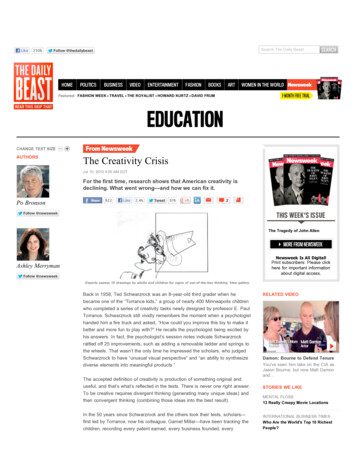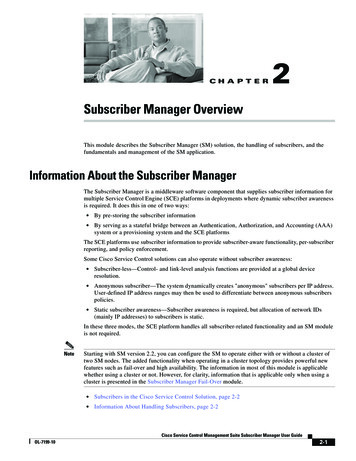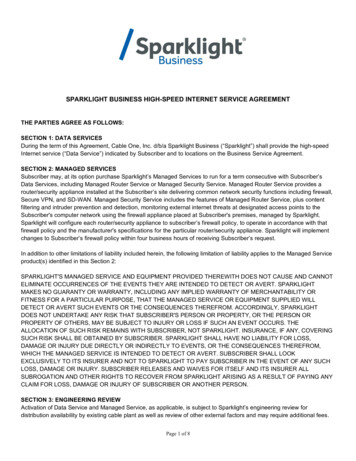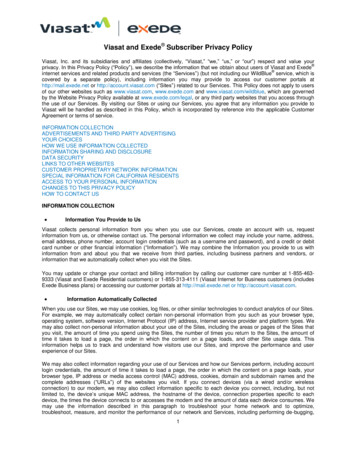
Transcription
Like250kSearch The Daily BeastFollow NTFASHIONBOOKSARTWOMEN IN THE WORLDFeatured: FASHION WEEK TRAVEL THE ROYALIST HOWARD KURTZ DAVID FRUMNEWSWEEK SUBSCRIBER HELPEDUCATIONCHANGE TEXT SIZEAUTHORSThe Creativity CrisisJul 10, 2010 4:00 AM EDTFor the first time, research shows that American creativity isdeclining. What went wrong—and how we can fix it.Po Bronson922Like2.4kTweet5762Follow @newsweekTHIS WEEK'S ISSUEThe Tragedy of John AllenNewsweek Is All Digital!Print subscribers: Please clickhere for important informationabout digital access.Ashley MerrymanFollow @newsweekExperts assess 10 drawings by adults and children for signs of out-of-the-box thinking. View gallery.Back in 1958, Ted Schwarzrock was an 8-year-old third grader when hebecame one of the “Torrance kids,” a group of nearly 400 Minneapolis childrenRELATED VIDEOwho completed a series of creativity tasks newly designed by professor E. PaulTorrance. Schwarzrock still vividly remembers the moment when a psychologisthanded him a fire truck and asked, “How could you improve this toy to make itbetter and more fun to play with?” He recalls the psychologist being excited byhis answers. In fact, the psychologist’s session notes indicate Schwarzrockrattled off 25 improvements, such as adding a removable ladder and springs tothe wheels. That wasn’t the only time he impressed the scholars, who judgedSchwarzrock to have “unusual visual perspective” and “an ability to synthesizediverse elements into meaningful products.”The accepted definition of creativity is production of something original anduseful, and that’s what’s reflected in the tests. There is never one right answer.To be creative requires divergent thinking (generating many unique ideas) andthen convergent thinking (combining those ideas into the best result).In the 50 years since Schwarzrock and the others took their tests, scholars—first led by Torrance, now his colleague, Garnet Millar—have been tracking thechildren, recording every patent earned, every business founded, everyresearch paper published, and every grant awarded. They tallied the books,Damon: Bourne to Defend TenureYou've seen him take on the CIA asJason Bourne, but now Matt Damonand.STORIES WE LIKEMENTAL FLOSS13 Really Creepy Movie LocationsINTERNATIONAL BUSINESS TIMESWho Are the World's Top 10 RichestPeople?
research paper published, and every grant awarded. They tallied the books,dances, radio shows, art exhibitions, software programs, advertising campaigns,hardware innovations, music compositions, public policies (written orimplemented), leadership positions, invited lectures, and buildings designed.Nobody would argue that Torrance’s tasks, which have become the goldstandard in creativity assessment, measure creativity perfectly. What’s shockingis how incredibly well Torrance’s creativity index predicted those kids’ creativeaccomplishments as adults. Those who came up with more good ideas onTorrance’s tasks grew up to be entrepreneurs, inventors, college presidents,authors, doctors, diplomats, and software developers. Jonathan Plucker ofIndiana University recently reanalyzed Torrance’s data. The correlation tolifetime creative accomplishment was more than three times stronger forchildhood creativity than childhood IQ.Like intelligence tests, Torrance’s test—a 90-minute series of discrete tasks,administered by a psychologist—has been taken by millions worldwide in 50languages. Yet there is one crucial difference between IQ and CQ scores. Withintelligence, there is a phenomenon called the Flynn effect—each generation,scores go up about 10 points. Enriched environments are making kids smarter.With creativity, a reverse trend has just been identified and is being reported forthe first time here: American creativity scores are falling.Kyung Hee Kim at the College of William & Mary discovered this in May, afteranalyzing almost 300,000 Torrance scores of children and adults. Kim foundcreativity scores had been steadily rising, just like IQ scores, until 1990. Sincethen, creativity scores have consistently inched downward. “It’s very clear, andthe decrease is very significant,” Kim says. It is the scores of younger childrenin America—from kindergarten through sixth grade—for whom the decline is“most serious.”WONDERWALLWhat Did Duchess Kate Buy FromTopshop?MONEY CRASHERS10 Great Career Fields for the FutureWONDERWALLWhy Did Justin Bieber Have the 'WorstBirthday' Ever?HUFFINGTON POSTJohn Brennan CIA Confirmation FacesNew DelayBUZZFEED15 Mesmerizing GIF and Song PairingsYOUR TANGOWho Will Downton Abbey's First BlackCharacter Be?BUZZFEED10 Terrible, Sexist, Insulting DiamondAdsMOST POPULARHe Still Doesn’t Get It!The ‘Hathahate’ Media Pile-OnIs Leno Facing Another Coup?Daddy DearestLena Dunham’s Intimate Improv NightRELATED STORIESTHE DAILY BEASTKate Portrait Artist Paints a New,Flattering VersionTHE DAILY BEASTThe Social Hierarchy of PreschoolersTHE DAILY BEASTHow Not to Helicopter7/10/10: Obamanomics, Immigration, Spy Games; Keys to Creativity; Israel and Iran; The Karen OberlinLoesser Show; Movie Review: Inception; From the Archives: McNamara's Mistake. SUBSCRIBE ORDOWNLOAD PODCAST: /id73329823The potential consequences are sweeping. The necessity of human ingenuity isundisputed. A recent IBM poll of 1,500 CEOs identified creativity as the No. 1“leadership competency” of the future. Yet it’s not just about sustaining ournation’s economic growth. All around us are matters of national andinternational importance that are crying out for creative solutions, from savingthe Gulf of Mexico to bringing peace to Afghanistan to delivering health care.Such solutions emerge from a healthy marketplace of ideas, sustained by apopulace constantly contributing original ideas and receptive to the ideas ofothers.It’s too early to determine conclusively why U.S. creativity scores are declining.One likely culprit is the number of hours kids now spend in front of the TV andplaying videogames rather than engaging in creative activities. Another is theAROUND THE WEBUS NEWS UNIVERSITY DIRECTORYDespite a Struggling Economy,Students Flock to CollegesWESTWOOD COLLEGEFour Strategies to Help You Feel LessOverwhelmedBANKRATE.COMSpoiled rotten: 11 most pampered richkids
playing videogames rather than engaging in creative activities. Another is thelack of creativity development in our schools. In effect, it’s left to the luck of thedraw who becomes creative: there’s no concerted effort to nurture the creativityof all children.Around the world, though, other countries are making creativity development anational priority. In 2008 British secondary-school curricula—from science toforeign language—was revamped to emphasize idea generation, and pilotprograms have begun using Torrance’s test to assess their progress. TheEuropean Union designated 2009 as the European Year of Creativity andInnovation, holding conferences on the neuroscience of creativity, financingteacher training, and instituting problem-based learning programs—curriculadriven by real-world inquiry—for both children and adults. In China there hasbeen widespread education reform to extinguish the drill-and-kill teaching style.Instead, Chinese schools are also adopting a problem-based learning approach.Plucker recently toured a number of such schools in Shanghai and Beijing. Hewas amazed by a boy who, for a class science project, rigged a tracking devicefor his moped with parts from a cell phone. When faculty of a major Chineseuniversity asked Plucker to identify trends in American education, he describedour focus on standardized curriculum, rote memorization, and nationalizedtesting. “After my answer was translated, they just started laughing out loud,”Plucker says. “They said, ‘You’re racing toward our old model. But we’re racingtoward your model, as fast as we can.’ ”Overwhelmed by curriculum standards, American teachers warn there’s noroom in the day for a creativity class. Kids are fortunate if they get an art classonce or twice a week. But to scientists, this is a non sequitur, borne out of whatUniversity of Georgia’s Mark Runco calls “art bias.” The age-old belief that thearts have a special claim to creativity is unfounded. When scholars gavecreativity tasks to both engineering majors and music majors, their scores laiddown on an identical spectrum, with the same high averages and standarddeviations. Inside their brains, the same thing was happening—ideas werebeing generated and evaluated on the fly.Researchers say creativity should be taken out of the art room and put intohomeroom. The argument that we can’t teach creativity because kids alreadyhave too much to learn is a false trade-off. Creativity isn’t about freedom fromconcrete facts. Rather, fact-finding and deep research are vital stages in thecreative process. Scholars argue that current curriculum standards can still bemet, if taught in a different way.To understand exactly what should be done requires first understanding thenew story emerging from neuroscience. The lore of pop psychology is thatcreativity occurs on the right side of the brain. But we now know that if you triedto be creative using only the right side of your brain, it’d be like living with ideasperpetually at the tip of your tongue, just beyond reach.When you try to solve a problem, you begin by concentrating on obvious factsand familiar solutions, to see if the answer lies there. This is a mostly left-brainstage of attack. If the answer doesn’t come, the right and left hemispheres ofthe brain activate together. Neural networks on the right side scan remotememories that could be vaguely relevant. A wide range of distant informationthat is normally tuned out becomes available to the left hemisphere, whichsearches for unseen patterns, alternative meanings, and high-level abstractions.Having glimpsed such a connection, the left brain must quickly lock in on itbefore it escapes. The attention system must radically reverse gears, goingfrom defocused attention to extremely focused attention. In a flash, the brainpulls together these disparate shreds of thought and binds them into a newsingle idea that enters consciousness. This is the “aha!” moment of insight,
single idea that enters consciousness. This is the “aha!” moment of insight,often followed by a spark of pleasure as the brain recognizes the novelty ofwhat it’s come up with.Now the brain must evaluate the idea it just generated. Is it worth pursuing?Creativity requires constant shifting, blender pulses of both divergent thinkingand convergent thinking, to combine new information with old and forgottenideas. Highly creative people are very good at marshaling their brains intobilateral mode, and the more creative they are, the more they dual-activate.Is this learnable? Well, think of it like basketball. Being tall does help to be a probasketball player, but the rest of us can still get quite good at the sport throughpractice. In the same way, there are certain innate features of the brain thatmake some people naturally prone to divergent thinking. But convergentthinking and focused attention are necessary, too, and those require differentneural gifts. Crucially, rapidly shifting between these modes is a top-downfunction under your mental control. University of New Mexico neuroscientist RexJung has concluded that those who diligently practice creative activities learn torecruit their brains’ creative networks quicker and better. A lifetime of consistenthabits gradually changes the neurological pattern.A fine example of this emerged in January of this year, with release of a studyby University of Western Ontario neuroscientist Daniel Ansari and Harvard’sAaron Berkowitz, who studies music cognition. They put Dartmouth musicmajors and nonmusicians in an fMRI scanner, giving participants a one-handedfiber-optic keyboard to play melodies on. Sometimes melodies were rehearsed;other times they were creatively improvised. During improvisation, the highlytrained music majors used their brains in a way the nonmusicians could not:they deactivated their right-temporoparietal junction. Normally, the r-TPJ readsincoming stimuli, sorting the stream for relevance. By turning that off, themusicians blocked out all distraction. They hit an extra gear of concentration,allowing them to work with the notes and create music spontaneously.Charles Limb of Johns Hopkins has found a similar pattern with jazz musicians,and Austrian researchers observed it with professional dancers visualizing animprovised dance. Ansari and Berkowitz now believe the same is true fororators, comedians, and athletes improvising in games.The good news is that creativity training that aligns with the new science workssurprisingly well. The University of Oklahoma, the University of Georgia, andTaiwan’s National Chengchi University each independently conducted a largescale analysis of such programs. All three teams of scholars concluded thatcreativity training can have a strong effect. “Creativity can be taught,” saysJames C. Kaufman, professor at California State University, San Bernardino.What’s common about successful programs is they alternate maximumdivergent thinking with bouts of intense convergent thinking, through severalstages. Real improvement doesn’t happen in a weekend workshop. But whenapplied to the everyday process of work or school, brain function improves.So what does this mean for America’s standards-obsessed schools? The key isin how kids work through the vast catalog of information. Consider the NationalInventors Hall of Fame School, a new public middle school in Akron, Ohio.Mindful of Ohio’s curriculum requirements, the school’s teachers came up with aproject for the fifth graders: figure out how to reduce the noise in the library. Itswindows faced a public space and, even when closed, let through too muchnoise. The students had four weeks to design proposals.Working in small teams, the fifth graders first engaged in what creativity theoristDonald Treffinger describes as fact-finding. How does sound travel throughmaterials? What materials reduce noise the most? Then, problem-finding—
materials? What materials reduce noise the most? Then, problem-finding—anticipating all potential pitfalls so their designs are more likely to work. Next,idea-finding: generate as many ideas as possible. Drapes, plants, or large kiteshung from the ceiling would all baffle sound. Or, instead of reducing the sound,maybe mask it by playing the sound of a gentle waterfall? A proposal fordouble-paned glass evolved into an idea to fill the space between panes withwater. Next, solution-finding: which ideas were the most effective, cheapest,and aesthetically pleasing? Fiberglass absorbed sound the best but wouldn’t besafe. Would an aquarium with fish be easier than water-filled panes?Then teams developed a plan of action. They built scale models and chosefabric samples. They realized they’d need to persuade a janitor to care for theplants and fish during vacation. Teams persuaded others to support them—sometimes so well, teams decided to combine projects. Finally, they presenteddesigns to teachers, parents, and Jim West, inventor of the electric microphone.Along the way, kids demonstrated the very definition of creativity: alternatingbetween divergent and convergent thinking, they arrived at original and usefulideas. And they’d unwittingly mastered Ohio’s required fifth-grade curriculum—from understanding sound waves to per-unit cost calculations to the art ofpersuasive writing. “You never see our kids saying, ‘I’ll never use this so I don’tneed to learn it,’ ” says school administrator Maryann Wolowiec. “Instead, kidsask, ‘Do we have to leave school now?’ ” Two weeks ago, when the schoolreceived its results on the state’s achievement test, principal Traci Buckner wasmoved to tears. The raw scores indicate that, in its first year, the school hasalready become one of the top three schools in Akron, despite having openenrollment by lottery and 42 percent of its students living in poverty.With as much as three fourths of each day spent in project-based learning,principal Buckner and her team actually work through required curricula,carefully figuring out how kids can learn it through the steps of Treffinger’sCreative Problem-Solving method and other creativity pedagogies. “Thecreative problem-solving program has the highest success in increasingchildren’s creativity,” observed William & Mary’s Kim.The home-game version of this means no longer encouraging kids to springstraight ahead to the right answer. When UGA’s Runco was driving throughCalifornia one day with his family, his son asked why Sacramento was thestate’s capital—why not San Francisco or Los Angeles? Runco turned thequestion back on him, encouraging him to come up with as many explanationsas he could think of.Preschool children, on average, ask their parents about 100 questions a day.Why, why, why—sometimes parents just wish it’d stop. Tragically, it does stop.By middle school they’ve pretty much stopped asking. It’s no coincidence thatthis same time is when student motivation and engagement plummet. Theydidn’t stop asking questions because they lost interest: it’s the other wayaround. They lost interest because they stopped asking questions.Having studied the childhoods of highly creative people for decades, ClaremontGraduate University’s Mihaly Csikszentmihalyi and University of Northern Iowa’sGary G. Gute found highly creative adults tended to grow up in familiesembodying opposites. Parents encouraged uniqueness, yet provided stability.They were highly responsive to kids’ needs, yet challenged kids to developskills. This resulted in a sort of adaptability: in times of anxiousness, clear rulescould reduce chaos—yet when kids were bored, they could seek change, too. Inthe space between anxiety and boredom was where creativity flourished.It’s also true that highly creative adults frequently grew up with hardship.Hardship by itself doesn’t lead to creativity, but it does force kids to becomemore flexible—and flexibility helps with creativity.
more flexible—and flexibility helps with creativity.In early childhood, distinct types of free play are associated with high creativity.Preschoolers who spend more time in role-play (acting out characters) havehigher measures of creativity: voicing someone else’s point of view helpsdevelop their ability to analyze situations from different perspectives. Whenplaying alone, highly creative first graders may act out strong negativeemotions: they’ll be angry, hostile, anguished. The hypothesis is that play is asafe harbor to work through forbidden thoughts and emotions.In middle childhood, kids sometimes create paracosms—fantasies of entirealternative worlds. Kids revisit their paracosms repeatedly, sometimes formonths, and even create languages spoken there. This type of play peaks atage 9 or 10, and it’s a very strong sign of future creativity. A Michigan StateUniversity study of MacArthur “genius award” winners found a remarkably highrate of paracosm creation in their childhoods.From fourth grade on, creativity no longer occurs in a vacuum; researching andstudying become an integral part of coming up with useful solutions. But thistransition isn’t easy. As school stuffs more complex information into their heads,kids get overloaded, and creativity suffers. When creative children have asupportive teacher—someone tolerant of unconventional answers, occasionaldisruptions, or detours of curiosity—they tend to excel. When they don’t, theytend to underperform and drop out of high school or don’t finish college at highrates.They’re quitting because they’re discouraged and bored, not because they’redark, depressed, anxious, or neurotic. It’s a myth that creative people havethese traits. (Those traits actually shut down creativity; they make people lessopen to experience and less int
Torrance’s tasks grew up to be entrepreneurs, inventors, college presidents, authors, doctors, diplomats, and software developers. Jonathan Plucker of Indiana University recently reanalyzed Torrance’s data. The correlation to lifetime creative accomplishment was more than three times stronger for childhood creativity than childhood IQ.










